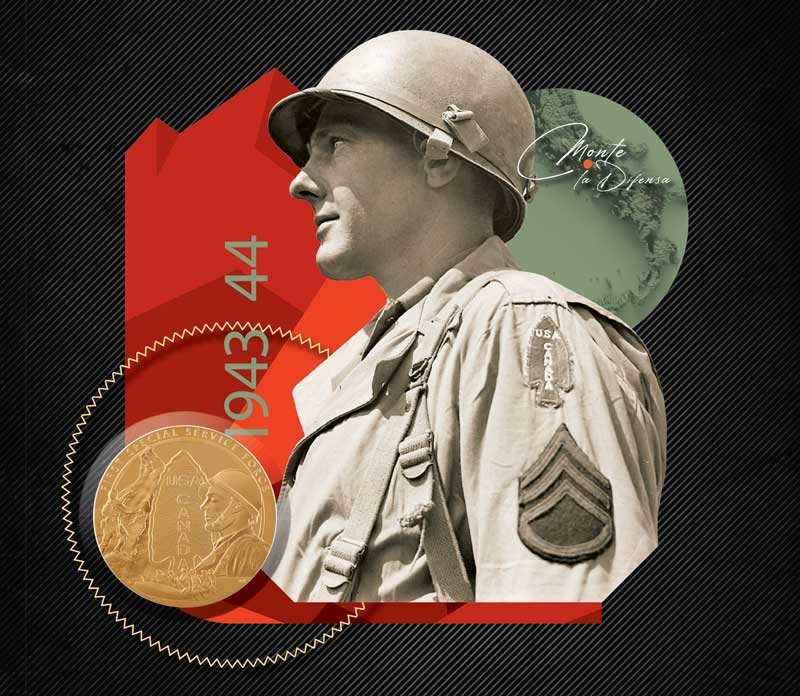
An unidentified sergeant of the First Special Service Force at the Anzio beachhead on April 30, 1944. The Canadian-American unit was awarded a U.S. Congressional Gold Medal (inset) in 2015.[C.E. Nye/LAC/3302126; CWM/20180339-001; U.S. Signals Corps/LAC/3378683]
The First Special Service Force was still pretty much a secret when its commandos boarded a cruise liner, then First World War-era rail cars known as “forty and eights” (each held 40 men and eight horses) and finally trucks before they made the precarious climb up a Nazi-infested Italian mountain in the late fall of 1943.
It had been 17 months since the ragtag collection of prospectors, miners, steel workers and other improbable Canadians and Americans first set foot in Helena, Mont., for some of the most intensive military training ever undertaken. Now they were about to open the route to Rome—and Allied victory.
Their first operation in August 1943 had been somewhat anticlimactic, taking the Aleutian island of Kiska off Alaska after its 5,400 Japanese occupiers had already left. No one beyond those with an immediate need to know had any idea that this was the first fully integrated, highly trained binational special forces unit in the Allied armies.
Though covered by the Canadian and American press, accounts of the Kiska landings had made no mention of their singular nature. “Canucks Help Retake Kiska,” declared The Globe and Mail; “U.S.-Canadian Forces Take Kiska,” headlined The New York Times. Even the force’s name was a secret.
Now the commandos, who would come to be known as “The Black Devils,” were champing at the bit, anxious to bring their hard-earned skills, cohesion and professionalism to bear on the best Hitler had to offer. Italy was a priority, and there would be no hiding the fact—certainly from the Germans—that something entirely different had been added to the equation.
“These men are trained to fight in forests, on mountains or in snow, and always to attack.”
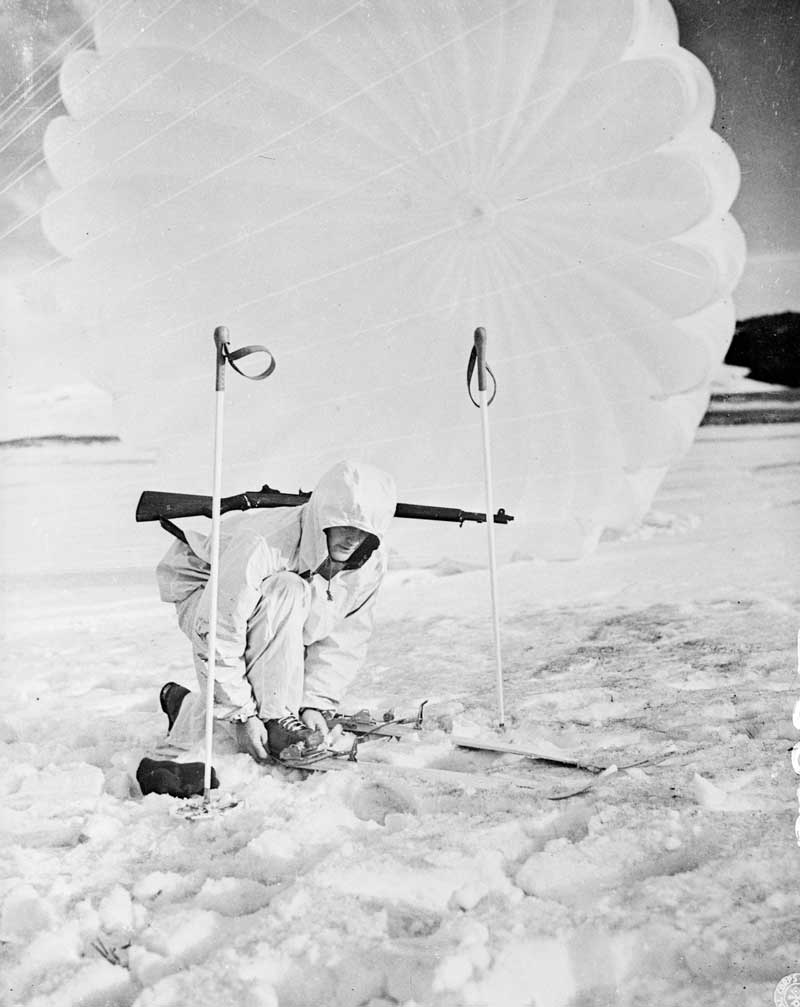
A Devil’s Brigade trainee during a January 1943 exercise in Montana. [U.S. Signals Corps/LAC/3378683]
The U.S. Fifth and the British Eighth armies had been fighting northward on either side of the Apennine Mountains, which extend almost the entire length of mainland Italy. But by November 1943, the American “war of mud mules and mountains” had stalled at the formidable belt of Axis fortifications dubbed the Winter Line. Spanning the breadth of the Italian peninsula, it was commanded by celebrated Generalfeldmarschall Albert Kesselring.
“It was defended by some of the best and most experienced German troops in all of Europe,” wrote Joseph A. Springer in his 2001 oral history The Black Devil Brigade. “From their mountain fortifications, the German panzergrenadier and paratrooper divisions fought a savage, desperate delaying action that had stopped the Allied advance in the Liri Valley.”

Generalfeldmarschall Albert Kesselring meets with officers on the Italian front.[Nazi Propaganda Ministry/Recovered by U.S. Sgt. Eli Wallach/United States Holocaust Memorial Museum/33790]
The commandos who would come to be known as “The Black Devils” were champing at the bit.
The central point of the west side of the defence was Monte la Difensa, a 1,000-metre-high pile of volcanic granite that dominated the Garigliano River valley and, along with its sister peak Monte la Remetanea, was key to opening the Liri Valley and the ancient Highway 6 into the Italian capital.
After months of mountain warfare, a depleted and exhausted U.S. 3rd Infantry Division had fought over the difficult and costly terrain of la Difensa before they were forced to withdraw in mid-November. Subsequent attempts by the British 56th and U.S. 36th divisions also failed to wrest the peak from elements of three panzergrenadier regiments.
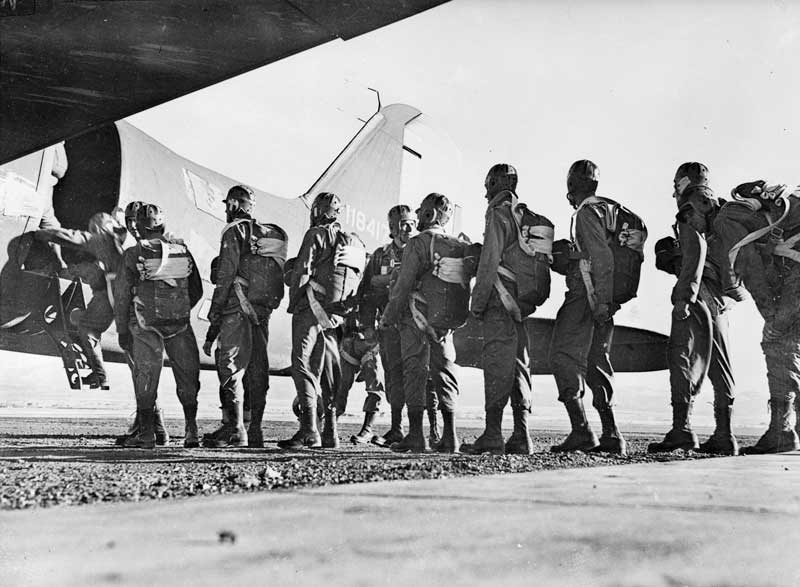
Parachutes at the ready, brigade trainees board a Douglas C-47 in Montana in August 1947.[U.S. Signals Corps/LAC/3378674]
All three regiments of the First Special Service Force boarded deuce-and-a-halfs after noon on Dec. 1 and headed north to their forward staging areas, 16 long and rugged kilometres from the mountain. About to face the bloodied and battle-hardened elite of Hitler’s Wehrmacht, they were still wearing summer uniforms.
The 1st Battalion of the 2nd Regiment, under the command of 28-year-old Lieutenant-Colonel Thomas (Tom) MacWilliam from Cails Mills, N.B., was to lead the attack.
Before the fighting, however, and in advance of the impossible climb that got them to the summit, they had an exhausting, 11-hour forced march through mud and driving rain to the base of la Difensa. They arrived undetected at 3:30 a.m. on Dec. 2.
The battalion’s 1st Company would be the tip of the spear and two scouts of its recon party were to play critical roles in charting the route to the mountain face and up to the top: Corporal Thomas (Tom) Fenton of Montreal and Sergeant Howard Van Ausdale, a 40-something half-Dutch, half-Cherokee from Delaware, Okla., with what his executive officer described as “a superb sense of terrain.” Their platoon leader, Sergeant Donald MacKinnon from Saint-Lambert, Que., said they had both been prospectors before the war and were his best scouts, “effective in working their way through rough terrain quickly and quietly.”
“Van was king among scouts,” Private Joe Dauphinais of Starbuck, Man., told Springer, describing how his relatively advanced age was mitigated by the fact he had “tramped around mountains” all his life. “He was a real mountain man; he could read terrain as you could read a book. He found an excellent route for us to reach the front of the cliff without being detected by the Germans.
“I told him, ‘If it wasn’t for you, we’d all be dead.’”
On the way in, they encountered U.S. soldiers leading mules loaded with the bodies of their brethren enshrouded in mattress covers. “That made a very strong impact,” said Major Edward Thomas from Nashville, Tenn.
Staff-Sergeant Bill Story of Winnipeg had witnessed the scene of the earlier fighting while on a scouting mission about a week before the operation.
“I was assigned the area the 3rd and 36th divisions had hit as they tried to get to the top,” he said. “As the fog lifted and I looked around, I could see bodies that had been lying there for a month.
“The survivors were under fire the whole time and couldn’t go out and get the dead. There were enough dead bodies to tell us what route to use.”
And so, unlike those before them, the special force commandos chose to ascend la Difensa’s steep north face, a daunting, two-day climb requiring ropes and other mountaineering paraphernalia. It would nevertheless afford the attackers the element of surprise and the additional advantage, once on top, of fighting downhill against bunkers facing the other way.
The “quiet” part came thanks to the earth-shattering roar of some 925 artillery pieces laying down 64,000 rounds on, and around, the mountain, which had the effect of eliminating almost any chance the heavily laden commandos would be heard as they made their way over the feature’s steep crevices, cliffs and rock faces.
The 1st Battalion started the ascent. Rank-related distinctions gave way to more immediate and practical considerations when it came to equipment and supplies. Everyone carried whatever they could—water, arms, ammunition, first-aid kits.
“There were no officers going without weight,” said Captain Fred Hubbard of Jamaica, N.Y. “We were like the men, packrats. We either carried ammunition or bazookas or whatever. Personally, I was a water boy; I carried a five-gallon Jerry can of water plus my arms.
“You can carry those Jerry cans either full or empty. If you had them half-full, and you moved up a rope, for instance, it would take you right off your feet. It would swish. So you had to carry it full or empty.”
It was wet, cold and arduous. Hands were so stiff from the chill and slippery from the rain that gripping the ropes, especially with all that weight, was difficult. The commandos leaped across a chasm a metre wide that looked and felt like 15.
Sergeant Walter (Pop) Lewis of Butte, Mont., was weighed down with an M1 rifle and a load of rifle grenades. He called the journey up “a hell of a time,” particularly the ropes.
“It was the last section of line and I kept spinning and swinging around and around because of the weight I was carrying,” he said. “It was a rough climb.”
Other than rendering the summit’s occupants unaware of the location and method of the impending attack, the hailstorm of artillery fire, which earned la Difensa the nickname “the Million-Dollar Mountain,” had little effect on the Germans. They had taken shelter in caves and bunkers as soon as the barrage began.
Once on top, MacKinnon’s platoon with scouts Fenton and Van Ausdale was assigned the initial attack. The American Cherokee led them single file along a narrow, rocky path. Allied shells were passing overhead like freight trains.
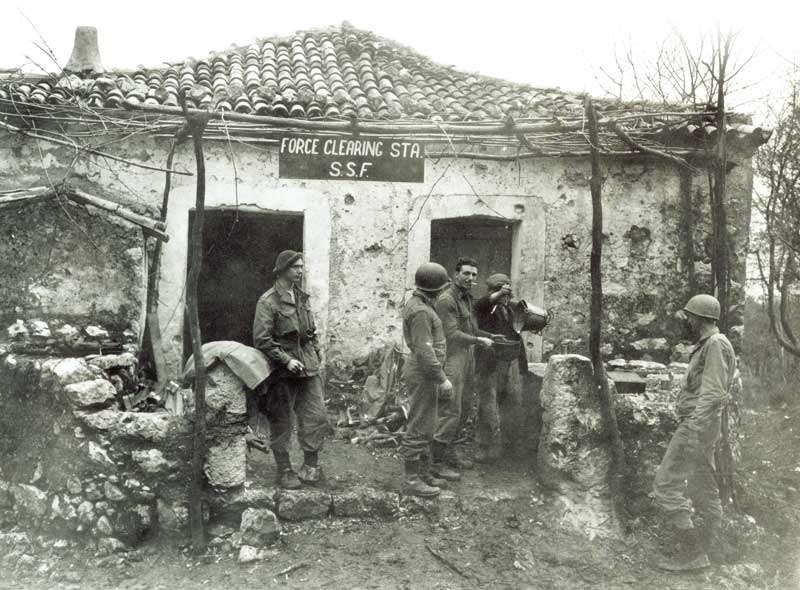
Force commandos pause at a clearing station behind the front lines.[Canadian Corps of Signals/CWM/19820091-001]
They were almost on top of the Germans when someone kicked a stone. A sentry challenged the two commando scouts. “Someone shot,” said MacKinnon, “and that’s when machine-gun fire opened up all around us.”
Van Ausdale shot a sentry. The man rolled down the cliff, landing alongside Sergeant Lorin Waling of Helena, Mont. “He was gasping for air,” said Waling. “That was my first initiation in combat. But there was nobody that had bad feelings about killing; it was just the way it was. I found out it was quite the thrill to do it, really.”
Lewis was in the process of unpacking his rifle grenades when he saw a figure rise up in the pre-dawn light about three metres in front of him. A German.
“It was an old-fashioned quick-draw,” he said. “I was really wheeling it, but he beat me to it. He opened up with his machine pistol, sending three slugs into my back. He cut the lumbar muscle about in two and opened up an eight- or nine-inch gash, exposing the fatty tissue around my kidney.
“I went down like an ox that had been hit on the head with an axe. It was… just like a tremendous weight had hit me, or like a damned good punch. They ripped through me—all the way through—clear across the right side of my back. It just missed my backbone by a quarter of an inch. The pain was intense.”
The action was now fast and furious. And close.
The commandos fixed bayonets. American Sergeant Joe Glass started tossing grenades. “I threw them at everybody. There was a Kraut down below me over a ledge shooting tracers straight up in the air. I just dropped one right down on his head. They’re good weapons, if you know how to use them.
“It was pretty hectic and I’m not sure what happened in those first few seconds,” said Glass. “But in no time at all, I didn’t have a grenade left.”
Private Kenneth Betts, an American airborne trooper who had joined the commando unit in Helena, manned a machine gun and exhausted its supply of ammunition belts within minutes. He grabbed a rifle off a dead comrade and moved forward.
“It was hairy up there for about an hour,” said Betts. “We had never been in combat before, but our training took over. I don’t think I saw anyone sitting there with their hands over their ears. All I saw were guys with their fingers on the triggers. That is unless, of course, they were dead.
“But let me tell you something,” he added, “you have one second—one second—that’s just about all, one second, of being a green soldier and after that first second, you are either a seasoned veteran or a dead rookie; one or the other.”
Dauphinais, the private from Manitoba, stepped into the open and immediately got pinned down by an MG-42 machine gun spitting 1,550 rounds of high-velocity, 7.92mm rounds per minute, or about 25 a second.
“The black devils are all around us. [They are on us] every time we come into the line, and we never hear them come.”
The German was so close, Dauphinais said, he “could have spit in the bugger’s eye.” But his foe was on high ground and had to shoot down at the Canadian in the dark with the mounted weapon, making the German’s job of taking him out more difficult.
“It was only a matter of time, really, I didn’t have a chance. They plugged me.”
He passed out and when he came to, he had the good sense to stay absolutely still. He attributes his survival to his training, tough as it was.
“I didn’t panic. I didn’t move a muscle and when they raised their fire to take on the guys behind me, I made my move and got the hell out of there.”
Glass may have been out of grenades, but he had plenty of ammunition. He was behind a rock, shooting up a storm, when a German with a Schmeisser MP-40 submachine gun hit him with a 9mm bullet in the pinky finger, knocking the M1 out of his hand. Another round hit the rocks beside him and sprayed his face and right eye with granite chips.
“I backed off and went around to the left,” said Glass. “I got behind another rock when I saw Germans giving up all over the place. To the left of us was a machine-gun crew giving up and I thought, ‘Jesus, we’ve got to get him now.’”
But the German sergeant with the Schmeisser wasn’t surrendering. The company commander, Captain Bill Rothlin of Berkeley, Calif., and Private Syd Gath of Winnipeg arrived and took up positions on either side of Glass.
“I told them both, ‘Whatever you do, don’t look over this rock yet, because this guy really has us zeroed in and he’s not giving up. And if you do, you’re going to get hit!’
“Both Syd and Captain Rothlin looked over the rock at the same time and this Kraut hit them both right through the head. My rifle was covered in brains. God, it was terrible.”
Gath slumped over onto MacKinnon who, unaware he had been hit, admonished him for leaning on him.
“As I said that, he rolled over and I saw the gaping wound to his head,” said MacKinnon. “He had died instantly. It really stunned me. Syd had been a good friend from the beginning, a very likeable guy.”
Glass went over to the dazed MacKinnon and asked him how he was doing. Gath was the first man MacKinnon had seen killed in action. “Well, I’m scared!” he replied. “We’re all scared,” Glass told him.
“So have a cigarette!”
The two men lit up smokes and resumed firing. Shortly after, Glass directed a buddy with a better angle to the German. “I think he got him finally.”
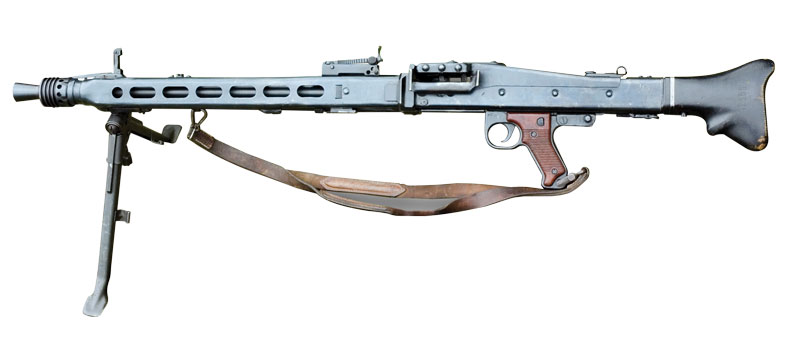
A Maschinengewehr 42, or MG-42, could fire up to 1,550 rounds of ammo per minute.[Alamy Stock/2KYRB8P]
In two hours on Dec. 3, the commandos captured a critical piece of high ground the Germans had held onto since the first week of November despite the best efforts of British and American regulars. Seventy-five elite German soldiers were dead, 43 captured. The commandos counted 20 killed and 160 wounded.
“In one of the most important battles of the Italian campaign, Allied troops drove their way up and over the highest peaks of the Mount Camino mass…. Monastery Hill, La Maggiore, and La Difensa are in our hands,” correspondent Herbert Matthews declared in a New York Times story the following day.
But the victory, while significant, had not yet been consolidated. The losses were heavy—and continuing to mount. Relief wasn’t immediately forthcoming.
In a violent and confused firefight lasting the next six days, the commandos of the First Special Service Force were all but isolated as they held their hard-won ground against repeated German counterattacks, artillery fire and near-incessant mortar barrages. Then the enemy brought in Nebelwerfers, six-barrelled rocket launchers. The Allied armies called them “screaming meemies.”
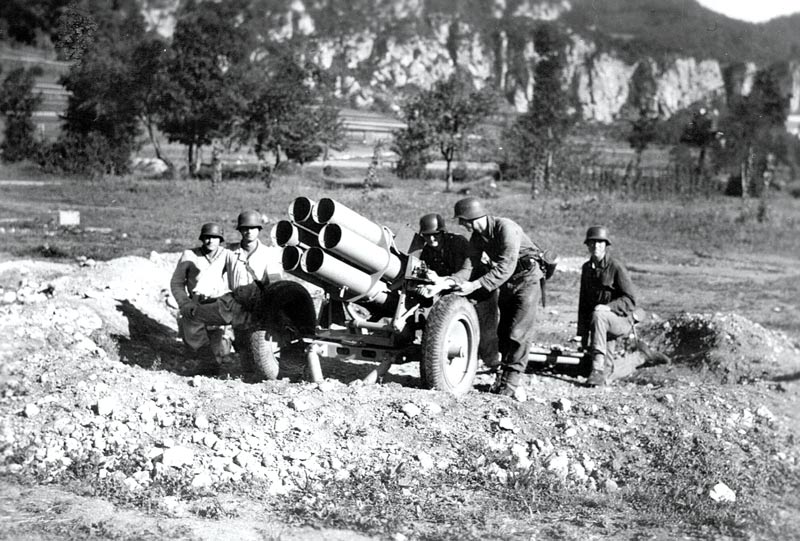
German troops pose with a Nebelwerfer rocket launcher on the Italian Front in 1943.[Wikimedia]
“What began as a mountain assault now became a siege that would test the stamina, fortitude, and endurance of the Forceman on Difensa,” wrote Springer.
By the time 3rd Regiment and service battalion men arrived carrying critical ammunition, water, rations and blankets on their backs, the commandos were already succumbing to hypothermia and exhaustion in the rain, snow and falling temperatures. Many of the wounded had been peppered with rock fragments.
Dauphinais began making his way down the line, his arm shot clean through and his rifle reduced to just the barrel by MG-42 fire.
“As I was moving between the rocks, I saw some of my buddies lying together in one area—all dead,” he said. “Their brains were knocked out, all from head shots. The snipers were sniping with Schmeissers and those buggers knew how to use them.
“We had been together for over a year, so you would think that looking at those guys would shock us silly, but we accepted it immediately. We knew it was something that was bound to happen to any of us.”
Some of the officers ditched their signature carbines for the same M1 rifles the enlisted men were using. This, they deduced, limited their chances of being targeted by snipers who continued to work well after the main battle ended. Their tracer bullets helped German mortar batteries zero in on their targets.
MacWilliam, the battalion commander from New Brunswick, and several of his aides were killed when he took a direct hit on the head from a mortar round. “I looked back just in time to see them disappear,” said Lewis. “It was just a red mist.”
German prisoners were being led down the mountain; some didn’t make it after word got around that surrendering enemy had duped and shot some commandos.
“Some of the guys didn’t take prisoners unless they were told to,” said Sergeant Gil McNeese of Chicago. “Hell, I shot a few myself.”
Said T4 John Dawson, another Illinois native: “Some would check to see how much ammo the German would have left and if he was clean out of ammo, they would do him in.”
A medic eventually attended to Lewis and his gaping back wound, then told him to lie still. He did, until a German counterattack landed him the middle of the action and “lying still was no longer an option.” He managed to move to a small ledge.
“What began as a mountain assault became a siege that would test the stamina, fortitude, and endurance of the Forceman.”
“The Krauts were about fifty yards away, so I pulled out my .45 and started blazing away. I must have been putting them right there because this drew fire, and I mean a lot of fire.
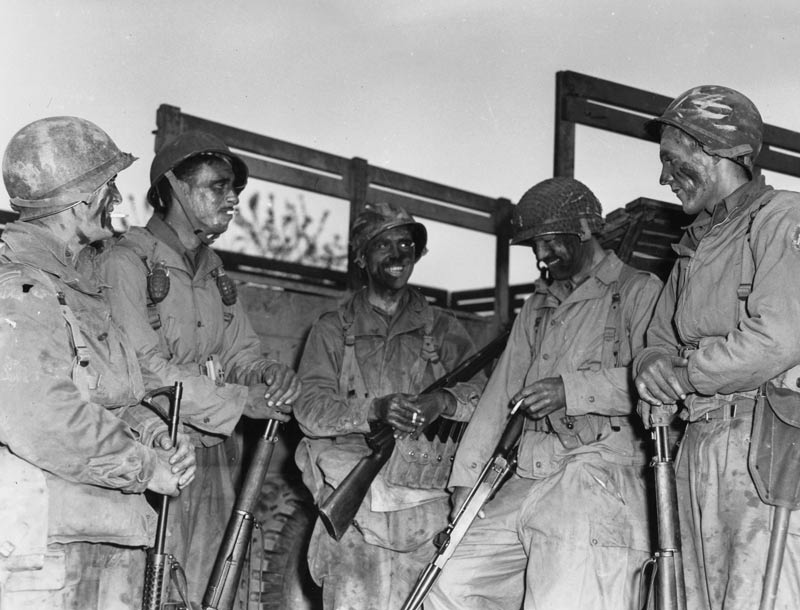
Devil’s Brigade commandos, their faces blackened for night operations, take a break in Italy. [CWM/19930012-061]
“As I was looking right down the sight, one bullet hit my .45 square on the muzzle. It blew my pistol back into my hand and dislocated my thumb. My knuckle was sheared off and my finger bone went back into my hand. I pulled my thumb out and also pulled my finger bone out of my hand.”
Lewis’s fighting was over. The wounded Dauphinais helped him down to a point on the mountain where medics could pick him up. Lewis’s stretchered descent, punctuated by a particularly dicey encounter with a German mortar crew, would take two days.
During the course of battle, the First Special Service Force took some 511 casualties, or roughly a quarter of its total combat strength.
Meanwhile, la Difensa would be celebrated in the papers back home. Correspondents, including the syndicated American reporter Ernie Pyle, the Montreal Star’s Sholto Watt and Hungarian-American photographer Robert Capa, were sending reports and pictures detailing the exploits of the new force as best as censors would allow.
Writing for the Toronto Daily Star, Clinton Conger eventually alluded to “the Devil’s Brigade” and the diary entries of a German PoW who, in an apparent reference to their boot-blacked faces, lamented: “The black devils are all around us every time we come into the line. We never hear them come.”
A legend had been born, and not just a fighting one.
“Their reputation as ‘scavengers’ of food also travelled far and wide,” James Wood wrote in “North American Exceptionalism in Wartime: Media Representation of the First Special Service Force,” published in a 2012 edition of the Calgary Papers in Military and Strategic Studies.
Wood described how Robert Vermillion of the United Press accompanied the commandos as they returned from a patrol in no man’s land with “a wounded German soldier, a wheelbarrow full of sweet potatoes, bushels of peanuts, two dozen eggs and one rabbit.”
Such exploits were many and served as raw material for Bill Mauldin’s wildly popular “Willie and Joe” cartoon series depicting the lives of two fictional American soldiers in the Anzio beachhead, where the brigade would engineer a monumental breakout in the spring of 1944.
“The men of the [Force] take a tremendous pride in their international composition,” wrote Watt, who accompanied them for parts of the Italian Campaign. “You couldn’t tell whether you were talking to Americans or Canadians in the Force, and indeed the Force gives the impression of having formed something new, a synthesis of North America, but of North America at its best.”
The commandos would fight on at Monte la Remetanea, through the mountains of Italy and up the Liri Valley, suffering 77 per cent casualties.
At Anzio, they fought for 99 days without relief. Here, the unit’s night patrols would distribute their trademark stickers on German corpses and fortifications for the first time. They bore the unit’s signature arrowhead patch and a slogan written in German: “Das dicke Ende kommt noch” or, roughly, “The worst is yet to come,” implying that a larger force was on its way.
Rome would fall on June 4, 1944, where the Devil’s Brigade became the first Allied unit to consolidate its entry into the city, capturing six to eight bridges over the Tiber in a single day.
They moved on and joined in Operation Dragoon, the August 1944 invasion of southern France, and fought the Battle of Port Cros in which they captured five German-held forts on the island of Port-Cros.
“Since their dramatic, three-month performance at Anzio beachhead, everybody knows them,” reported Conger. “The Allied armies in Italy know the men of the force by their special, baggy-panted mountain uniforms and shoulder patches.
“The public back home knew them during Anzio as the combined Canadian-U.S. combat group. Finally, they completely released their organizational name and history after they landed in France.
“To me, during the fortnight I spent with the force in southern France, the outstanding thing about it is its spirit of offence. These men are trained to fight in forests, on mountains or in snow, and always to attack.”
But the very things that made the First Special Service Force uniquely effective were some of the same things that ensured its political demise—namely, its binational makeup and high casualty rate.
On Oct. 7, 1944—the same day Conger’s tribute was published—the headquarters chief of the Canadian army in England, Lieutenant-General Kenneth Stuart, his hands all but tied by complex administrative challenges and the unit’s irreplaceable Canadian losses, advised disbanding it. Beyond the hundreds of commandos who had died in battle, the unit’s turnover rate was a whopping 600 per cent.
“This unit appears now to be submerged to such an extent with the U.S. forces that the value to Canada of its retention is no longer apparent,” wrote Stuart. “I recommend that the Canadian element of the Special Service Force be disbanded and that the personnel be returned to the U.K. for reallocation.”
And so it was that, after a final parade in Villeneuve-Loubet, France, on Dec. 5, 1944, the First Special Service Force—the Devil’s Brigade—ceased to exist.
“It was the saddest day of my life, I think,” said Dauphinais. “When they ordered ‘Americans stand fast; Canadians fall out in a column of threes,’ there were tears falling all over the bloody place, among all of these tough bastards.

Lieutenant Henry H. Rayner of Toronto briefs his platoon on April 20, 1944.[C.E. Nye/LAC/3396066]
“Canadians were falling out that I thought were Americans and Americans were standing still who I thought were Canadians,” he told Springer. “I didn’t know who was what. There was no nationality in that bloody outfit.”
The Canadians were returned to their own army. Some of the American element were transferred to exhausted U.S. airborne regiments, while the remainder were reorganized to form the 474th Infantry Regiment, complete with its own anti-tank company, heavy machine guns, mortars and vehicles.
The First Special Service Force had lasted just two-and-a-half years, but its exploits were monumental and its doctrine, training and methods would form the basis of future special operations forces, including Canada’s. Just nine commandos of the Devil’s Brigade survive at this writing, two of them Canadian.
The popular 1968 movie The Devil’s Brigade gave the unit’s memory new life, albeit a Hollywood account of its colourful existence through Monte la Difensa, starring the likes of William Holden, Cliff Robertson and Richard Dawson.
The film would have done well to have posted a disclaimer like the one that preceded episodes of “SAS: Rogue Heroes,” a recent BBC television series about the first British Special Air Service: “The events depicted which seem most unbelievable…are mostly true.”
Advertisement


















